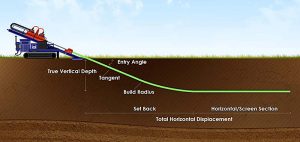How Far Can Horizontal Drilling Reach?
Horizontal drilling, a technique widely used in the oil and gas industry, has revolutionized the way we extract valuable resources from beneath the Earth’s surface. This method offers numerous advantages, including increased well productivity and minimized environmental impact. But just how far can horizontal drilling reach? Let’s delve into the details and explore the factors that determine the maximum reach of this technology.
The Basics of Horizontal Drilling
Horizontal drilling involves creating a wellbore that deviates from the vertical plane and extends horizontally through the rock formations. This technique allows access to larger areas of hydrocarbon reserves and enhances the recovery of resources that were once difficult to extract through conventional vertical drilling.

Factors Influencing Maximum Reach
Several factors play a crucial role in determining how far horizontal drilling can reach:
- Rock Formation: The type and consistency of the rock formations have a significant impact on drilling reach. Soft and less abrasive formations are more conducive to longer horizontal sections.
- Drilling Technology: Advances in drilling technology, such as improved drill bits and enhanced drilling fluids, have extended the maximum reach of horizontal drilling.
- Reservoir Properties: The properties of the reservoir, including its depth, pressure, and permeability, affect the achievable horizontal drilling distance.
- Wellbore Stability: Maintaining the stability of the wellbore is crucial for preventing collapses that could limit drilling reach.
- Geological Challenges: Geological features like faults and fractures can impact drilling direction and restrict horizontal reach.
Record-Breaking Horizontal Drilling Achievements
Over the years, impressive records have been set in the realm of horizontal drilling:
1. Longest Horizontal Reach
In 2021, a remarkable achievement was made in the Permian Basin, where a horizontal well reached an astounding length of over 10,000 feet. This record-breaking reach demonstrates the industry’s continuous efforts to push the boundaries of drilling technology.
2. Deepwater Horizontals
Horizontal drilling isn’t limited to land-based operations. In offshore drilling, companies have successfully extended horizontal wells beneath the ocean floor, tapping into deep-sea reservoirs that were once considered unreachable.
The Future of Horizontal Drilling
As technology continues to evolve, the future of horizontal drilling looks promising. Ongoing research and development aim to overcome current limitations and push drilling distances even further.

1. Enhanced Materials
New materials with superior strength and durability are being developed to ensure wellbore stability over longer horizontal sections.
2. Advanced Sensors
State-of-the-art sensors and imaging technologies enable real-time monitoring of drilling conditions, allowing operators to make precise adjustments and optimize drilling reach. Find out more information about horizontal drilling here.
3. Automation and Robotics
The integration of automation and robotics reduces human intervention during drilling, enhancing efficiency and safety while extending drilling reach.
Conclusion
Horizontal drilling has revolutionized the oil and gas industry by enabling access to previously untapped reserves. The maximum reach of horizontal drilling depends on various factors, including rock formations, drilling technology, and reservoir properties. With ongoing advancements and record-breaking achievements, the future holds exciting possibilities for pushing the boundaries of drilling distances even further.

